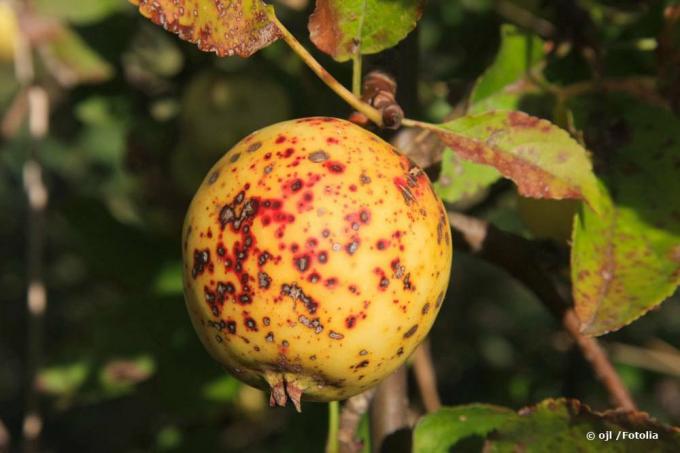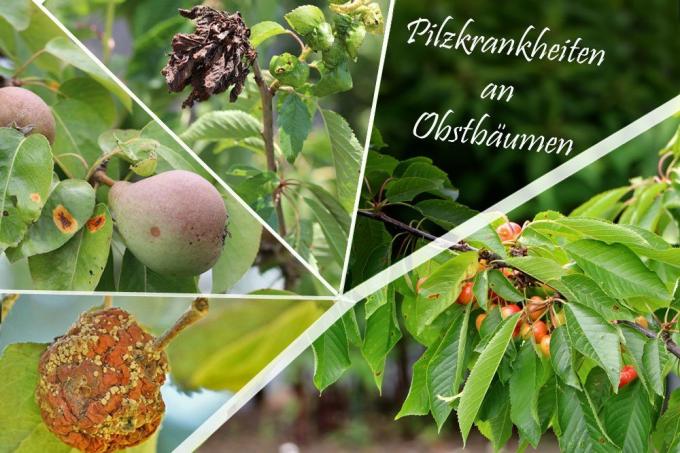
table of contents
- Fungal diseases from trees
- causes
- Prevent
- Recognize the 10 most common fungal diseases on the fruit tree
- 1. Apple scab
- 2. Pear grid
- 3. Leaf tan
- 4. mildew
- 5. Monilia fruit rot
- 6. Fruit tree cancer
- 7. Red pustular disease
- 8. Soot Spot Disease
- 9. Spray blotch disease
- 10. Verticillium wilt
Even during the flowering in spring, the gardener looks forward to a rich fruit harvest. However, apples, pears and the like are at risk if fungal diseases spread rapidly, especially due to incorrect care, an unsuitable location or during a damp summer. Countermeasures that are gentle on trees and fruits only help if the damage is detected early on. Chemical pesticides, on the other hand, should remain the exception, especially in the hobby garden and on the orchard.
Fungal diseases from trees
causes
Mushrooms and trees have always formed an often indispensable, but sometimes also fatal alliance. While many forest mushrooms together with some tree species are just as valuable for both partners as If the symbiosis is essential for survival, other fungi on the fruit tree cause serious ones Clinical pictures. In these species, the pathogen is often not visible to the naked eye, only the symptoms and the consequences of its penetration and growth are visible to the viewer.
Fungal diseases rarely occur “just like that”, but always have a cause. This has to be recognized and eliminated in order to get the problem under control and to treat the infected trees successfully. Infections with unwanted fungal pathogens occur mainly on these occasions:
- humidity: for example in rainy summers or damp winters
- Injuries: for example as a result of pruning in damp weather
- frost: if the bark bursts open in severe frost and sunshine at the same time, fungi can penetrate
- blossom: Fungal pathogens infect the fruit tree blossom, disease often only shows itself when the fruit is ripe
- leaves: infected leaves, left behind in autumn or used for mulching, transmit fungal spores
- Cut back: Trees that are rarely pruned develop dense crowns which, due to the moisture that does not dry out, form a breeding ground for fungal diseases
- Plant spacing: close planting distance promotes fungal infections
Furthermore, fungi infect trees that have been damaged in advance particularly often. Fruit trees that are weakened due to an unsuitable location and / or insufficient care belong to the risk group for a fungicidal infestation: After all, the natural defense mechanisms of these trees no longer have anything against the pathogens to oppose.
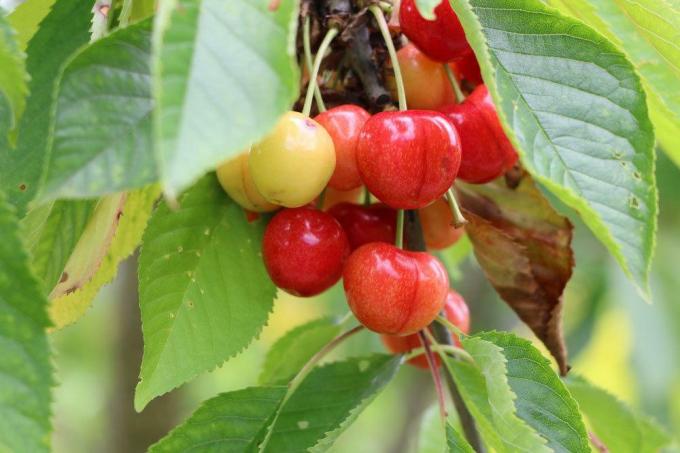
Prevent
Anyone who knows the causes of possible fungal diseases can counteract them by taking appropriate preventive measures. Above all, these include:
- Compliance with the recommended planting distance
- Choice of a suitable location (sunny, sheltered, not too humid)
- regular cut back for thinning
- Treatment of cuts (e.g. B. by brushing with tree resin)
- Removal and disposal of autumn leaves (if necessary with household waste)
- needs-based care (watering, fertilizing)
- Excess supply is just as harmful as undersupply
Furthermore, when pruning the fruit trees, you should always only use sharp and disinfected ones Use pruning tool to make a transfer from one tree to another along this path prevent. For example, an at least 70% alcohol solution is suitable for this.
tip: Some types of fruit are particularly sensitive to certain fungal diseases. Instead of fighting these over and over again, it is better to choose resistant varieties from the outset when planting. This applies, for example, to apple varieties that are resistant to scab, to gooseberry varieties that are resistant to powdery mildew or sweet and sour cherries that are not very sensitive to Monilia.
Recognize the 10 most common fungal diseases on the fruit tree
There are countless fungal pathogens, but they only prefer certain or attacked related fruit species. Others, on the other hand, can only be found on berries or pome fruits. However, a few pathogens are real generalists and do not stop at any fruit tree. These include, for example, the widespread Monilia fruit rot. At this point we briefly explain the 10 most common fungicidal diseases on the fruit tree, how you can recognize and combat them.
1. Apple scab
The scab disease caused by the fungus Venturia inaequalis mainly affects apple trees, but can also occur on pears, cherries and peaches. The disease manifests itself through brown-black spotted leaves, which are soon thrown off, and later star-shaped cracks on the fruits. The fruits are basically still edible, but they rot quickly and therefore cannot be stored.
Scab occurs especially after a mild and humid spring and when the trees grow too dense due to insufficient pruning and therefore dry poorly. Preferably plant resistant or insensitive varieties. Treat an infected fruit tree with a copper-containing fungicide, and the fallen leaves should definitely be removed and disposed of - the fungal spores overwinter in it.
2. Pear grid
The pear grate only affects pear trees which, after infection, develop conspicuous, wart-shaped and yellow-brown spots on the leaves from May onwards. However, the disease affects not only foliage development, but also growth and fruit harvest. Cut the infested trees back into the healthy wood and dispose of the clippings in the household rubbish. burn it up. Since the causative fungus overwinters on neighboring juniper bushes, you should also remove these.
3. Leaf tan
You can recognize the leaf tan by the brown foliage that gives it its name, which is thrown off prematurely in the middle of summer. The fruits of infected trees are not edible and, like the infested leaves, must be removed and disposed of as early as possible - but under no circumstances via the compost! A strong pruning is essential. The pathogen mainly affects cherries, apricots and quinces, but sometimes also apple and pear trees.
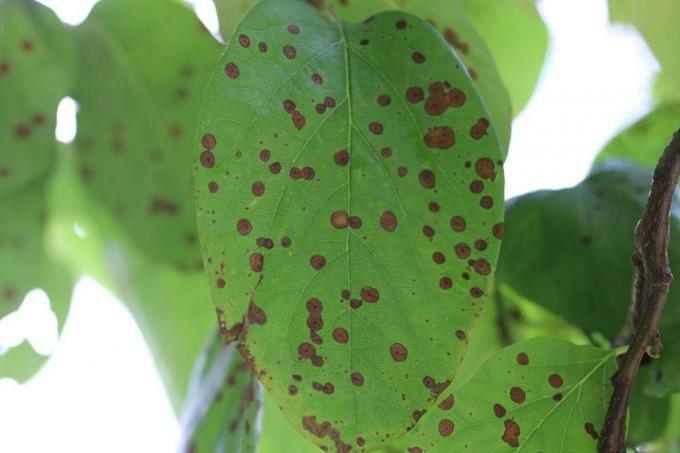
4. mildew
Powdery mildew diseases are also common on fruit trees. The gardener distinguishes between two forms: The Powdery mildew, also known as fair weather powdery mildew, occurs mainly in warm weather and sunshine. It shows itself through a whitish mushroom lawn on leaves and shoots that can be easily wiped off with your fingers. Of the Downy mildew on the other hand, it shows up in cool and rainy summers when the foliage has no opportunity to dry off and the fungal spores can penetrate this.
The so-called apple powdery mildew shows up early on the young leaves, as it overwinters directly on the tree in its leaf scales. Remove the infected leaves and spray the trees several times with an interval of several days a mixture of whole milk / raw milk and water (1 part water, 5 parts milk) or whey and water (ratio 1:1). If this home remedy doesn't help, you can use a fungicide. When planting, give preference to apple varieties that are resistant to powdery mildew.
5. Monilia fruit rot
The fruit rot caused by fungi of the genus Monilia affects almost all types of fruit grown in Germany. Symptoms of the disease are the characteristic rotten spots with the round mold pads. The fruits are no longer edible and should be removed and disposed of with household waste. To prevent Monilia fruit rot, you should use any remaining fruit (so-called "Fruit mummies") should not be left hanging over the winter months, but just like the leaves in autumn dispose.

6. Fruit tree cancer
The fruit tree cancer, which occurs frequently and mainly in apple and pear trees, is caused by fungi of the species Nectria galligena. It occurs mainly in regions with a high rainfall. Typical characteristics of an infection are:
- sunken, brown-red spots on the bark
- bursting bark
- withering branches and shoots
- Bulging
The disease can only be combated by completely removing infected parts of the plant, although larger wounds should be treated with a wound closure agent after pruning. To avoid re-infection, dispose of the clippings as well as infested fruits and the fallen leaves.

7. Red pustular disease
In particular stone fruits of the genus Prunus such as plums and apricots, but also cherries and all pome and nut fruit varieties can be attacked by red pustular pathogens. These penetrate through dead plant parts - for example twigs and branches that have frozen back in winter or fruit mummies - into living trees and attack healthy parts of the plant from here. As a preventive measure, you should always cut away dead branches and twigs and do not leave any stumps behind.
8. Soot Spot Disease
If a black, soot-like coating appears on ripe fruits, it is soot-stain disease. The stains are only superficially on the fruit peel and can be removed with thorough washing. Once removed, you can safely eat infected fruit. The disease cannot be combated, only prevented by taking appropriate measures. Infested fruit should always be removed.
9. Spray blotch disease
The so-called spray stain disease only occurs on sweet and sour cherries. The treatment is carried out through the use of herbal tonics, which you can purchase in specialist shops or make yourself. For example, it has proven to be generally effective for combating fungal diseases Horsetail broth proven, which, however, must be used early and preventively.
The causative agent of the spray blotch disease always overwinters in the fall foliage and infects the trees again in the following spring around the time of flowering. For this reason, the old leaves must be carefully collected and disposed of as early as autumn.
10. Verticillium wilt
In contrast to many other fungal pathogens, Verticillium fungi do not penetrate the leaves or injuries to the bark or bark. of the wood into the fruit tree, but from the ground. By injuring the roots, they penetrate into the ducts and block them, so that the affected fruit trees suddenly begin to wither. The wilting symptoms initially appear on individual branches, but soon spread to the entire tree. Rescue is usually not possible, so all that remains is clearing. The Verticillium wilt is usually caused by a too moist surface or Causes waterlogging.
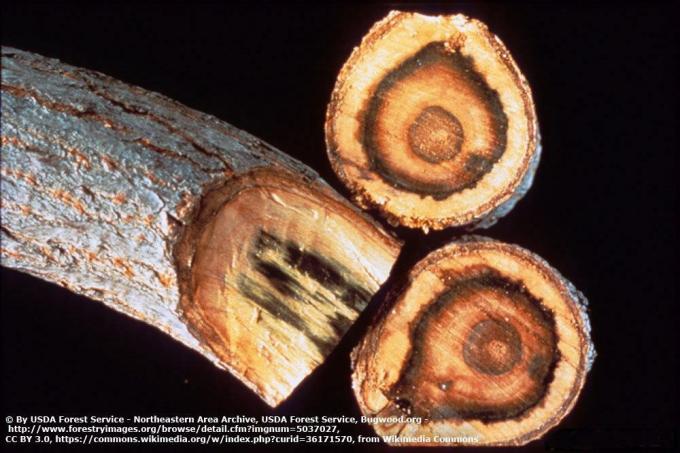
tip: Fungal diseases can be avoided by not opening the trees when it rains or when it is raining. generally cut in damp weather. The secateurs should stay in the shed even in frosty conditions.

